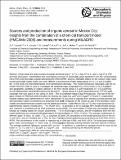Sources and production of organic aerosol in Mexico City: insights from the combination of a chemical transport model (PMCAMx-2008) and measurements
Author(s)
Tsimpidi, A. P.; Karydis, V. A.; Bei, Naifang; Pandis, S. N.; Lei, Wenfang; Molina, Luisa Tan; Zavala-Perez, Miguel Angel; ... Show more Show less
DownloadMolina-2011-Sources and production of organic aerosol in Mexico City.pdf (1.530Mb)
PUBLISHER_CC
Publisher with Creative Commons License
Creative Commons Attribution
Terms of use
Metadata
Show full item recordAbstract
Urban areas are large sources of organic aerosols and their precursors. Nevertheless, the contributions of primary (POA) and secondary organic aerosol (SOA) to the observed particulate matter levels have been difficult to quantify. In this study the three-dimensional chemical transport model PMCAMx-2008 is used to investigate the temporal and geographic variability of organic aerosol in the Mexico City Metropolitan Area (MCMA) during the MILAGRO campaign that took place in the spring of 2006. The organic module of PMCAMx-2008 includes the recently developed volatility basis-set framework in which both primary and secondary organic components are assumed to be semi-volatile and photochemically reactive and are distributed in logarithmically spaced volatility bins. The MCMA emission inventory is modified and the POA emissions are distributed by volatility based on dilution experiments. The model predictions are compared with observations from four different types of sites, an urban (T0), a suburban (T1), a rural (T2), and an elevated site in Pico de Tres Padres (PTP). The performance of the model in reproducing organic mass concentrations in these sites is encouraging. The average predicted PM[subscript 1] organic aerosol (OA) concentration in T0, T1, and T2 is 18 μg m[superscript −3], 11.7 μg m[superscript −3], and 10.5 μg m[superscript −3] respectively, while the corresponding measured values are 17.2 μg m[superscript −3], 11 μg m[superscript −3], and 9 μg m[superscript −3]. The average predicted locally-emitted primary OA concentrations, 4.4 μg m[superscript −3] at T0, 1.2 μg m[superscript −3] at T1 and 1.7 μg m[superscript −3] at PTP, are in reasonably good agreement with the corresponding PMF analysis estimates based on the Aerosol Mass Spectrometer (AMS) observations of 4.5, 1.3, and 2.9 μg m[superscript −3] respectively. The model reproduces reasonably well the average oxygenated OA (OOA) levels in T0 (7.5 μg m[superscript −3] predicted versus 7.5 μg m[superscript −3] measured), in T1 (6.3 μg m[superscript −3] predicted versus 4.6 μg m[superscript −3] measured) and in PTP (6.6 μg m[superscript −3] predicted versus 5.9 μg m[superscript −3] measured). The rest of the OA mass (6.1 μg m[superscript −3] and 4.2 μg m[superscript −3] in T0 and T1 respectively) is assumed to originate from biomass burning activities and is introduced to the model as part of the boundary conditions. Inside Mexico City (at T0), the locally-produced OA is predicted to be on average 60 % locally-emitted primary (POA), 6 % semi-volatile (S-SOA) and intermediate volatile (I-SOA) organic aerosol, and 34 % traditional SOA from the oxidation of VOCs (V-SOA). The average contributions of the OA components to the locally-produced OA for the entire modelling domain are predicted to be 32 % POA, 10 % S-SOA and I-SOA, and 58 % V-SOA. The long range transport from biomass burning activities and other sources in Mexico is predicted to contribute on average almost as much as the local sources during the MILAGRO period.
Date issued
2011-06Department
Massachusetts Institute of Technology. Department of Earth, Atmospheric, and Planetary SciencesJournal
Atmospheric Chemistry and Physics
Publisher
European Geosciences Union
Citation
Tsimpidi, A. P. et al. “Sources and production of organic aerosol in Mexico City: insights from the combination of a chemical transport model (PMCAMx-2008) and measurements during MILAGRO.” Atmospheric Chemistry and Physics 11 (2011): 5153-5168. Web. 20 Oct. 2011.
Version: Final published version
ISSN
1680-7324
1680-7316